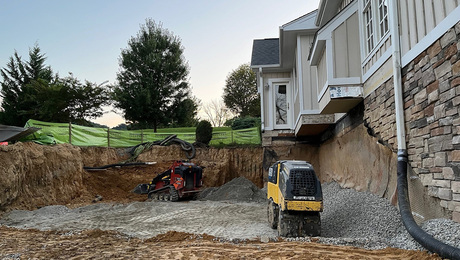
The U.S. Green Building Council (www.usgbc.org) has been the frontrunner of green building in the commercial sector for years, and is now in the process of turning its spotlight on the residential side. In November, more than 13,000 building professionals from both industries showed up at the USGBC’s Greenbuild Conference and Expo in Denver. The event revolved around the council’s Leadership in Energy and Environmental Design (LEED) certification system, offering first-hand experience from professionals using the program.
An addition to this year’s Expo was the Council’s LEED for Homes pilot program, which began in August of 2005. In development since 2000, LEED for Homes continues to evolve as participating builders and consultants around the country provide feedback through their own experiences with the certification process. For a home to be certified, the program requires the signature of someone who has received a LEED Professional Accreditation on the LEED Checklist form. Though many green certification programs exist throughout the country, LEED for Homes will be the first national program to require third-party verification, which advocates argue creates a more accurate measure of a home’s “greenness.” Involving a LEED for Homes Accredited Professional at the very beginning of a project is important to ensure a successful certification, advises Maureen Mahle of Steven Winter Associates, Inc., who discussed how green construction techniques are helping production builders build and market better homes.
Built Green connects with consumers
Market research conducted by Built Green of Colorado (www.builtgreen.org) found that consumers drive the green building market in the Denver area, but that their perceptions of what “green building” means are completely contrary to reality. The research found that consumers wouldn’t pay for a “Green Built” home unless there was clearly “something in it for them.” (Demonstrating how sustainable homes save on energy bills and provide healthier indoor air quality helped satisfy that “something.”) But what was surprising is that before learning about the Green Built program, consumers presumed that a healthy, environmentally friendly home meant it wasn’t as well built as a “normal” home. Built Green has countered that somewhat in their ad campaign, which, according to marketers, is contributing to a dramatic change in consumer perception.
Does it cost more to build green?
Kevin Stack, president of Northeast Natural Homes (www.northeastnaturalhomes.com) in Syracuse, New York, says that it doesn’t have to. But if there are higher initial costs they are quickly regained in energy savings within a few years. When approaching a new project he first views the home as an independent ecosystem; each system (heating, for example) is affected by another system (like insulation). Stack uses energy-efficient framing techniques — frequently called advanced framing or optimum valued engineering (OVE) — and rolls over the money saved on lumber into better insulation like spray foam. Stack doesn’t allow dumpsters on any of his job sites, which forces his crew to recycle materials, and one way he minimizes his company’s carbon footprint is by incorporating fly ash regularly in all of the concrete used for a job.
Chemical company goes green
BASF claims to be the world’s largest chemical company. Surprisingly, the company wasn’t self-conscious about being at a green building conference, where their reps touted BASF’s near-zero energy home in Paterson, New Jersey. Among the non-conventional mechanical systems is a Dawn Solar (www.dawnsolar.com) hot water system that sits directly under the roof’s shingles.
From the show floor:
A steep green roof. Green Roof Blocks just came out with a product for pitched roofs called Steep Green Packs. Fully saturated the packs weigh 17 lbs per sq ft. www.greenroofblocks.com
Education and training in the Northeast. Based in Boston, The Green Roundtable is offering programs to help architects and designers incorporate green design into their work. They’re working on developing programs for contractors, as well.
www.greenroundtable.org
FSC-certified will find you. Instead of searching for FSC-certified products, you can enter the products you’re looking for on the Forest Stewardship Council’s online product inquiry form. Your request will go out to people that carry the product and they’ll contact you.
www.findfsc.org
Products by the page. A growing free resource for green products and info is Green Building Pages.
www.greenbuildingpages.com
No-VOC caulks and adhesives. ChemLink has been making products for the commercial industry for more than 12 years. Now they’re moving into the residential market.
www.chemlinkinc.com
Chris Ermides is an assistant editor. Photo: Chris Ermides

























